Native Aquatic Plant Establishment Efforts in a High-Herbivore, Central Texas Reservoir ()
1. Introduction
Establishing native submerged aquatic vegetation in the presence of substantial herbivore densities can be difficult [1]. For example, red-eared sliders (Trachemysscripta elegans) prefer to feed on American eelgrass (Vallisneriaamericana), a commonly utilized submerged aquatic vegetation species for restoration in southern United States (U.S.) reservoirs, making them an obstacle in re-establishing eelgrass [2] [3] [4]. This dynamic is compounded when new herbivores, such as triploid grass carp (Ctenopharyngodonidella), are released into systems for management of invasive submerged aquatic vegetation, such as hydrilla (Hydrilla verticillata) [5] [6] [7].
Hydrilla, a rooted, nonnative submersed aquatic macrophyte, has infested U.S. waterbodies since the 1960s and is a long-term problem for many U.S. water resources [8] - [14]. Triploid grass carp have been widely used as semi-selective biological control agents for hydrilla [15] [16] [17] [18]. Unfortunately, efficacy has been inconsistent, with stocking densities necessary for controlling hydrilla frequently eliminating desirable submerged aquatic vegetation as well [7] [17]. The result is the loss of habitat and degradation of water quality and other associated ecosystem services for protracted periods [19] [20]. Actively protecting native plants from herbivory is therefore necessary for their re-establishment during invasive species management and ecosystem restoration, but more information is needed on design and species that can rapidly grow and spread in the face of herbivores [18]. The Lake Austin reservoir on the Lower Colorado River in central Texas, USA, has experienced hydrilla invasion, abundant native herbivores, introduction of triploid grass carp (Ctenopharyngodonidella), and occasional abiotic disturbances, such as high-water events [21] [22]. The result has been a recent—circa 2013—loss of native submerged aquatic vegetation, with associated changes in aquatic macroinvertebrate communities and fishery quality. In response, in 2015 reservoir managers began expanding restoration efforts to restore native submerged aquatic vegetation communities by increasing coverage of protected founder colonies of desirable plants throughout the reservoir [21] [23]. The purpose was to: 1) provide immediate structure and habitat for aquatic fauna; and 2) serve as founder colonies for vegetative spread once a threshold of seed and fragment production exceeds herbivory rates. Sites were established with herbivore exclosure pens of varying mesh sizes to evaluate herbivore effects on vegetation establishment efforts. The majority of the pens were planted with American eelgrass, whereas one was planted with a diversity of species to evaluate potential suitability for inclusion in future founder colony plantings. This information was then used to expand the extent of pens at each of the sites with suitable species. The objectives of this paper are to discuss submerged aquatic vegetation establishment results from this case history and their implications for management of similar systems facing herbivory pressure.
2. Study Site
Lake Austin is an impoundment of the Lower Colorado River currently maintained by the Tom Miller Dam northwest of Austin, TX, U.S. (Figure 1). Primary functions of the dam are to provide hydroelectricity and water supplies to the City of Austin. Completed in 1939, the dam was constructed on top of the remains of two other structures (completed in 1893 and 1912), both of which were
![]()
Figure 1. Native aquatic vegetation founder colony site locations on Lake Austin, TX, installed July 2015-2018; Lower Colorado River watershed in central Texas, USA (A) with map site callout (top), and (B) submerged aquatic vegetation establishment sites 1 - 7, American eelgrass sites 1 - 4 used for inferential testing (bottom), Google Earth Pro Version 7.3.
damaged by floods. Originally called Lake McDonald, both earlier dams were known as the Austin Dam. The reservoir is 32.5 km long, with a maximum width of 396 m, and covers approximately 740 ha.
Aquatic Plant History: Aquatic vegetation has been historically sparse in the lake, limited to small patches of a moderate diversity of native species. The exotic, invasive species Eurasian watermilfoil (Myriophyllumspicatum) was introduced in the 1960s in a misguided effort to improve fish and waterfowl habitat. Eurasian watermilfoil grew aggressively but unfortunately was a poor choice to meet the goal of its introduction, with improvements in waterfowl habitat never realized [24]. Additionally, Eurasian watermilfoil is recognized as poor habitat in comparison to native submerged aquatic vegetation stands for centrarchids and other fish species [25] [26]. Instead of providing benefits, excessive growth of Eurasian watermilfoil became problematic and required management by way of bi-annual drawdowns. A second exotic species, hydrilla, was reported in the lake in 1999, which by 2002 had spread to cover over 130 ha, greatly limiting water-based recreation, contributing to additional flooding, disrupting water supplies, and interfering with hydropower production [22]. Insufficient amounts of competing native vegetation present in the lake did little to prevent invasion by hydrilla and drawdown-management of Eurasian watermilfoil provided only short-term reductions in hydrilla extent.
Triploid grass carp were stocked for hydrilla control in the lake beginning in 2004. Hydrilla coverage was reduced to less than 16 ha by 2006 (Texas Parks and Wildlife Department surveys, personal communications) and remained at low levels through 2009, with a corresponding resurgence of Eurasian watermilfoil, which is less preferred as a food source by grass carp [27]. Coinciding with grass carp introductions, lake managers in 2004 began establishment of desirable native aquatic vegetation in the lake with the goal of producing a balanced aquatic ecosystem by providing additional wildlife habitat structure, preventing erosion, and improving water quality [21]. Techniques to establish native aquatic plants were applied by installation of herbivore-protected—PVC-coated welded-wire fenced—founder colonies to promote immediate habitat and propagule availability for natural spread in the lake once hydrilla growth was suppressed by grass carp. It was thought that these colonies, well protected from grass carp and other herbivores and/or consisting of species less palatable than hydrilla, would increase the recovery of desirable vegetation even while the herbivorous introduced fish remained in the lake.
However, rapid expansion of hydrilla extent in 2011 and 2012 during a drought-of-record and low flows through the reservoir triggered additional grass carp stocking. Subsequently (2013-present), there has been a near-complete elimination of unprotected native aquatic plants, both emergent and submerged, leaving only the protected installed native plant founder colonies remaining. Continuous native vegetation restoration efforts have been made by maintaining and expanding protected areas with anticipation that grass carp population attrition would provide opportunity for optimal founder colony performance—resulting in natural recovery of native vegetation on a lake-wide scale. As herbivore pressure imposed by triploid grass carp decreases, less preferred species were thought to be more likely to dominate vegetation recovery, hopefully reducing the likelihood that hydrilla will again overwhelm the system [18].
3. Materials and Methods
Between 2004 and 2015 founder colony sites were established at ten locations across Lake Austin [21]. Herbivore exclosures were typically small, and most did not survive up to 2018. In response to the slow rate of submerged aquatic vegetation recolonization believed to be due to the low densities present in the remaining exclosures, in 2015 managers established five sites where large pens would be installed with different fence mesh sizes and species survivorship would be evaluated (Figure 1). At four of the sites, two 1.5 m tall, 15 m parallel to the shoreline by 6 m perpendicular to the shoreline pens—one 5 × 5 cm mesh and one 10 × 10 cm mesh—were installed and planted with 36 American eelgrass transplants each. Transplants were colonies grown within 4-inch diameter nursery pots, herein referred to as “plantings”. Additional (similar numbers) demarcated unprotected or outside of the exclosures “control” plantings were made at each site. Within each pen, four ring cages—0.6 m diameter by 1.5 m tall—constructed with the same mesh as the pen in which each was placed were used to protect four random plantings to test for in-pen herbivore effects and overall pen integrity (Figure 2). These would function to re-vegetate the pen if breached by herbivores. The fifth pen site was 15 m long × 6 m wide and constructed out of 5 × 10 cm mesh. This pen was planted with creeping burhead (Echinodoruscordifolius), pickerelweed (Pontederiacordata), American white waterlily (Nymphaeaodorata), Illinois pondweed (Potamogetonillinoensis), grassleaf mudplantain (Heterantheradubia), and delta arrowhead (Sagittariaplatyphylla). Pens were installed at 0.6 - 0.9 m depths and extended above the water level by at least 0.6 - 0.9 m in all locations (Table 1).
![]()
Table 1. Native aquatic vegetation founder colony site characteristics on Lake Austin, TX, installed July 2015.
![]()
Figure 2. American eelgrass (Vallisneriaamericana) founder colony sites were installed in Lake Austin, TX, in July 2015: (top-left, July 2015)—containerized American eelgrass used for initial establishment; (top-right, July 2015)—newly planted herbivore exclusion pen with secondary ring cage protection; (middle-right, August 2015)—vegetative spread/ daughter plants from American eelgrass plantings; (middle-left, August 2015)—pen view at same time as previous photo; (bottom-left, September 2015)—vegetative spread/daughter plants from American eelgrass plantings along with native and non-native volunteers; (bottom right, September 2015)—pen view at same time as previous photo.
American eelgrass plantings percent survival and percent grazed from Sites 1 - 4 were used as dependent variables in a randomized complete block design with factor one being the spatial group—four blocks or four spatially similar locations/sites—and factor two the treatment—protection mesh size with three levels = none or control, 5 × 5 cm and 5 × 10 cm Sites were installed summer 2015 and data for statistical testing was taken in autumn 2015. Post-hoc multiple comparison tests were done with Student-Newman-Kewls; all tests were done at α = 0.05 using statistical software SigmaPlot Version 11.0 (Systat Software Inc., San Jose, CA). Site 5 was nominally observed for species survival and spread performance. Based upon the results with Sites 1 - 5, two additional submerged aquatic vegetation founder colony sites were established, Sites 6 - 7 and the 2015 Sites 1 - 5 were expanded, and all sites were evaluated and where necessary and replanted between 2016-2018 (Table 2 and Table 3).
![]()
Table 2. Species used for restoration on Lake Austin, 2015-2018.
![]()
Table 3. Lake Austin ecosystem restoration and native plant establishment sites 2015-2018.
4. Results & Discussion
Control (unprotected) plantings at Sites 1 - 4 had 100% mortality within 1 - 2 days of installation due to herbivory. After two and four weeks, Sites 1 and 2 (four total pens) had 100% survival in both mesh sizes, and plants had begun to spread, forming 2 - 3-ft diameter colonies via production of stolon daughter-plants (Figure 2). At Sites 3 and 4 there was 100% survival in the 5 × 5 cm mesh pens. However, grazing had occurred in the 5 × 10 cm mesh pens, including within the inner ring cages with similar mesh. We observed small basking turtles navigating through the larger mesh size on multiple occasions, but no such incursions were observed through 5 × 5 cm mesh.
In addition to American eelgrass, volunteer vegetation was observed inside of pens of both mesh sizes at Sites 1 and 2 including hydrilla (tubers), southern waternymph (Najas guadalupensis, seeds), muskgrass (Chara vulgaris, spores), and sago pondweed (Stuckenia pectinata, tubers and/or seeds), indicating that tuber and seed banks remained viable in some areas of the lake (Figure 2). No volunteers were observed within either sized mesh at Sites 3 or 4.
After eight weeks (September 2015), the smaller mesh pens at Sites 1 and 2 had 100% survival of the original plantings, and total coverage of submerged aquatic vegetation, predominantly American eelgrass, was between 80% - 100%, (Table 4). Survival of original plantings in the 2” × 4” pens at sites 1 and 2 was also 100%, though total submerged aquatic vegetation pen coverage was lower (40% - 65%), suggesting some herbivore incursion was occurring but at a lower frequency. At Sites 3 and 4, there was 100% survival of original plantings in the smaller mesh pens, whereas in the larger mesh pens survival of original plantings was approximately 31% and 75%, respectively (Table 4). Overall coverage of all submerged aquatic vegetation at Sites 3 and 4 was lower than at 1 and 2. There was a significant mesh treatment effect on both American eelgrass percent survival (P = 0.001, SNK = 5 × 5 cm mesh & 5 × 10 cm mesh > control) and percent
![]()
Table 4. American eelgrass (Val) survival and coverage (percent of pen area) metrics on 28 September 2015 Lake Austin, TX. Note all unprotected plantings had 0% survival or 100% herbivory within 48 hours.
grazed (P = 0.016, SNK = 5 × 5 cm mesh & 5 × 10 cm mesh < 5 × 10 cm mesh & control). These results confirm that, given the tremendous pressure of large herbivores—triploid grass carp, adult turtles—in Lake Austin, having mesh exclosures increases the odds of submerged aquatic vegetation survivability and spread. Even though there was not a significant pair-wise difference between the small and large mesh sizes on survival, having the smaller mesh further helped slow incursion of small herbivores (juvenile turtles) into the pens, enabling more rapid growth and spread of planted species as well as regrowth from the sediment seed bank.
Site 5, also a large mesh pen, was planted with creeping burhead, American white waterlily, Illinois pondweed, grassleaf mudplantain, pickerelweed, and delta arrowhead. All plantings of those species were observed to have survived and were spreading during each of the three assessments, with greatest spread observed with grassleaf mudplantain and Illinois pondweed. The survivorship and spread of plants in the 5 × 10 cm mesh pen might be due to species—burhead pickerelweed, arrowhead—being too fibrous for small turtles to consume. The authors selected these species based upon their ability to persist in the presence of low grass carp densities [17].
Sites were assessed again in May 2016 for vegetation coverage; percent survival and percent grazed were not assessed due to the original transplants not being distinguishable from first year above ground spread and growth. Similar to the results in 2015, all 5 × 5 cm American eelgrass pens had coverages ranging from 90% - 100%. The 5 × 10 cm pens in the southern Lake Austin reaches (Sites 1 and 2) were similar, but the pens at Sites 3 and 4 had American eelgrass coverages at 15% and 25% and total coverages at 65% and 85%, respectively. Coverages for both included volunteer hydrilla, bladderwort (Utricularia sp.), sago pondweed (Stuckeniapectinata), and Illinois pondweed, suggesting small turtles continue to gain access and graze selectively on American eelgrass (Table 5). Both the 5 × 10 cm American eelgrass pens nearest the dam (Sites 3 and 4), where cooler water is discharged into Lake Austin from Lake Travis, demonstrated less vegetative coverage. The 5 × 10 Site 5 pen was fully vegetated with Illinois pondweed (80%) being the dominate species after one year of establishment. Grassleaf mudplantain (10%), pickerelweed (15%), delta arrowhead (15%), and American white waterlily (1%) were also present (Supplemental Material).
With the findings of our side-by-side experiment, we used only 5 × 5 cm mesh and increased the number and size of the pens in Lake Austin from 2016-2018. We enlarged the pens previously installed at sites 1 - 5, and established two new sites along public shorelines (Supplemental Material, Table 3). Exclosures were planted with the most successful submerged aquatic vegetation species observed in 2015, American eelgrass, Illinois pondweed, and grassleaf mudplantain, as well as emergent macrophytes American waterwillow, pickerweed, and arrowhead. To date, American waterwillow has been the only plant to spread beyond the herbivore exclosures (Supplemental Material), owing to its natural resistance to herbivory, including to grass carp [17].
![]()
Table 5. Native and invasive aquatic species observed at founder colony sites located in Lake Austin; *volunteers (non-transplants).
The lack of natural re-vegetation of the reservoir, we believe, is due to herbivory rates exceeding seed production and tuberous spread, as well as natural hydrologic events in the basin. The Lower Colorado River watershed experienced heavy precipitation and inflow throughout the Edward’s Plateau streams, primarily the Llano River in 2016 and 2018, raising Lake Austin’s water level. This caused some overtopping of some exclosures, enabling triploid grass carp entry into the pens and reducing plant coverages within pens. There was limited damage to protective exclosures, and after removal of the interlopers, submerged aquatic vegetation coverage within the pens was replenished from colonies that survived in enclosed ring-cages (grass carp did not breach these cages), manual replanting efforts, and regeneration for sediment seeds or tubers (Supplemental Material).
5. Conclusions
Monitoring and maintenance are required for long-term SAV establishment and are being continued in Lake Austin past the initial installation/expansion phases. Herbivore populations will likely continue to decline due to triploid grass carp attrition, and founder colony propagule productivity will increase with pen expansions. Our approach has enabled identification of the exclosure attributes (e.g., finer mesh) and macrophyte species with the fastest growth and highest resiliency to herbivory. These included, American eelgrass, Illinois pondweed, grassleaf mudplantain, and American waterwillow in the Lake Austin system. Combined, the adaptive management approach should help overcome natural herbivory rates and hasten vegetative spread into unprotected areas of the reservoir, which is the ultimate restoration goal of this SAV-establishment project.
Managers of freshwater ecosystems facing similar SAV management and herbivory issues can utilize the results of this work at the onset of restoration efforts to maximize the likelihood of success on reduced timelines. Specifically, when faced with substantial herbivory pressures, managers should install large pens—that do not impede boat or other recreational uses—with finer mesh sizes coupled with herbivore resistant and fast-growing macrophyte species. As demonstrated, other notable benefits of the herbivore exclusion pens for managers to advantage include, direct aquatic habitat and faunal refuge; riparian vegetation erosion protection; and the potential to function as living laboratories to study sediment accretion dynamics, macroinvertebrate community composition and densities, and macrophyte succession dynamics in the absence of large herbivores or omnivores.
Supplemental Material
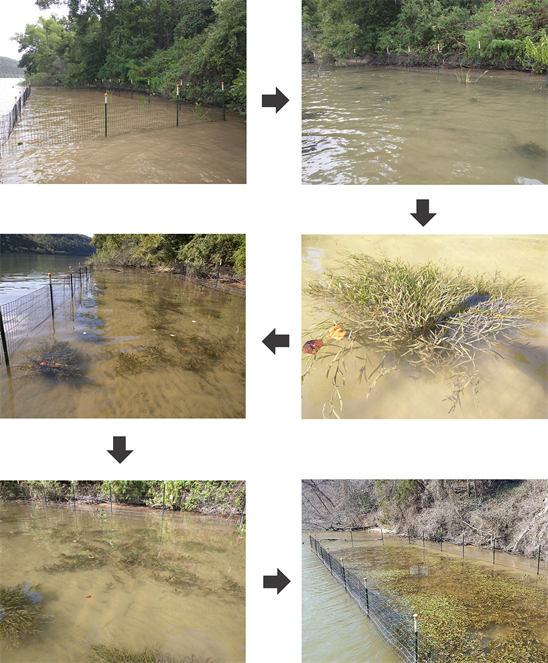
SM 1. The Site 5 founder colony site was installed in Lake Austin, TX, in July 2015: (top-left and right, July 2015)—newly constructed and planted pen; (middle-right, August 2015)—vegetative spread from grassleaf mudplantain (Heteranthera dubia) planting; (middle-left, September 2015)—total vegetative spread in pen grassleaf mudplantain and Illinois pondweed (Potamogeton illinoensis) pictured; (bottom-left, September 2015)—total vegetative spread in pen grassleaf mudplantain and Illinois pondweed pictured; (bottom-right, February 2016)—total vegetative spread in pen Illinois pondweed dominated.
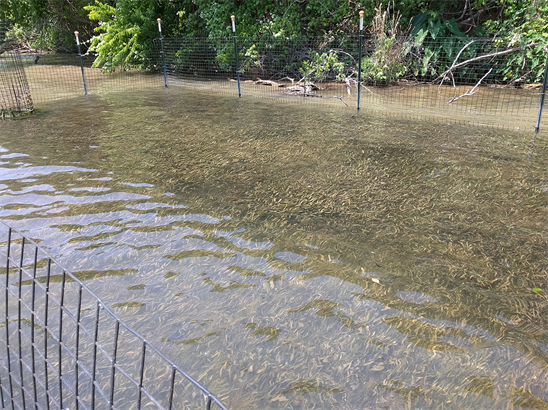
SM 2. American eelgrass (Vallisneria americana) full 5 × 5 cmmesh pen coverage (top) in May 2016, Lake Austin, TX.
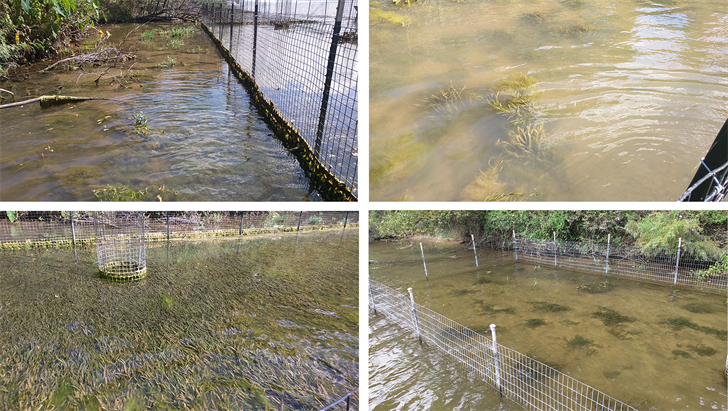
SM 3. Native aquatic vegetation established in pen expansion (top left and top right); dense vegetation establishment in 5 × 5 cm mesh pens (bottom left) and transplant survival and moderate spread in 5 × 10 cm mesh pens (bottom right, northern reaches), September 2016.
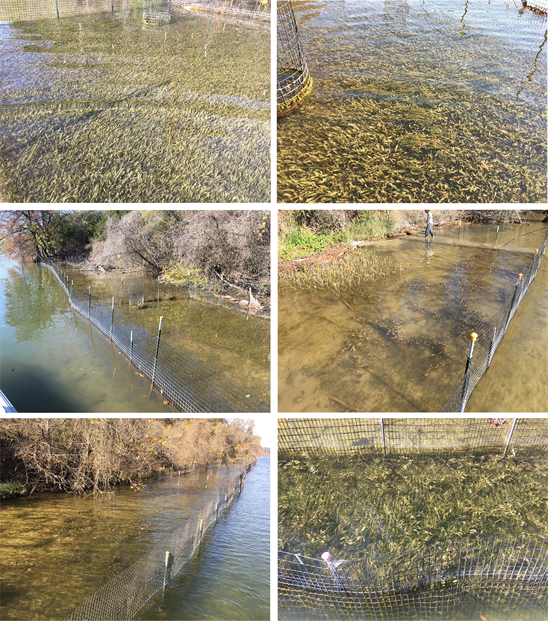
SM 4. Lake Austin restoration work assessment, December 2017; top left—original 2015 American eelgrass site, top right—small hydrilla recovery in protected areas indicated continued viable tuber and/or fragment bank, middle—functional protective sites near Commons Ford, bottom left—expanded megapen at Site 4, remained protective and functional, bottom right—2016 replanted pen with established aquatic vegetation.
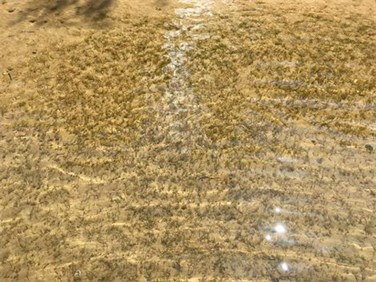
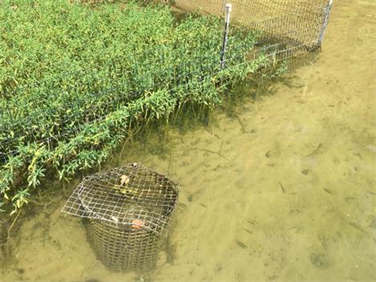
SM 5. Species beginning to spread beyond protective exclosures observed on Lake Austin, July 2017, left—American waterwillow, right—spikerushes.
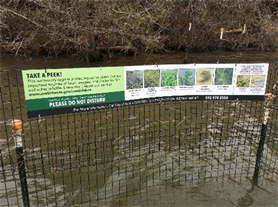
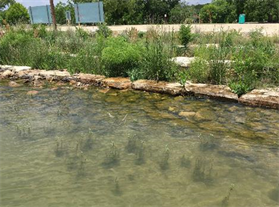
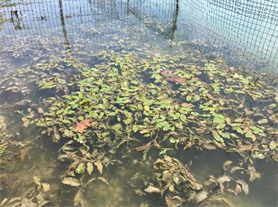
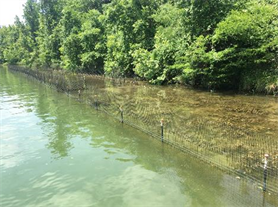
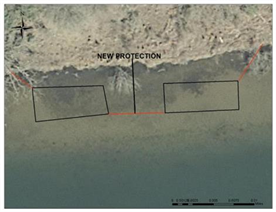
![]()
SM 6. Lake Austin restoration examples, 2015-2018.
![]()
SM 7. Emergent/riparian vegetation appears to be more able to establish and spread behind founder colony protection, potentially due to reduction in heavy erosive-wave forces.
![]()
![]()
SM 8. Illinois pondweed establishment and spread condition as of June (left) and August (right) 2019.
![]()
![]()
![]()
![]()
SM 9. American eelgrass establishment and spread condition, 2019. Pictured is occurring and observed sexual reproduction, a positive self-propagating sign.
![]()
![]()
![]()
SM 10. American eelgrass spreading from protective exclosures—into other protected areas—post-herbivore-flood breaches. Bottom left to right, one month from August to September 2019.